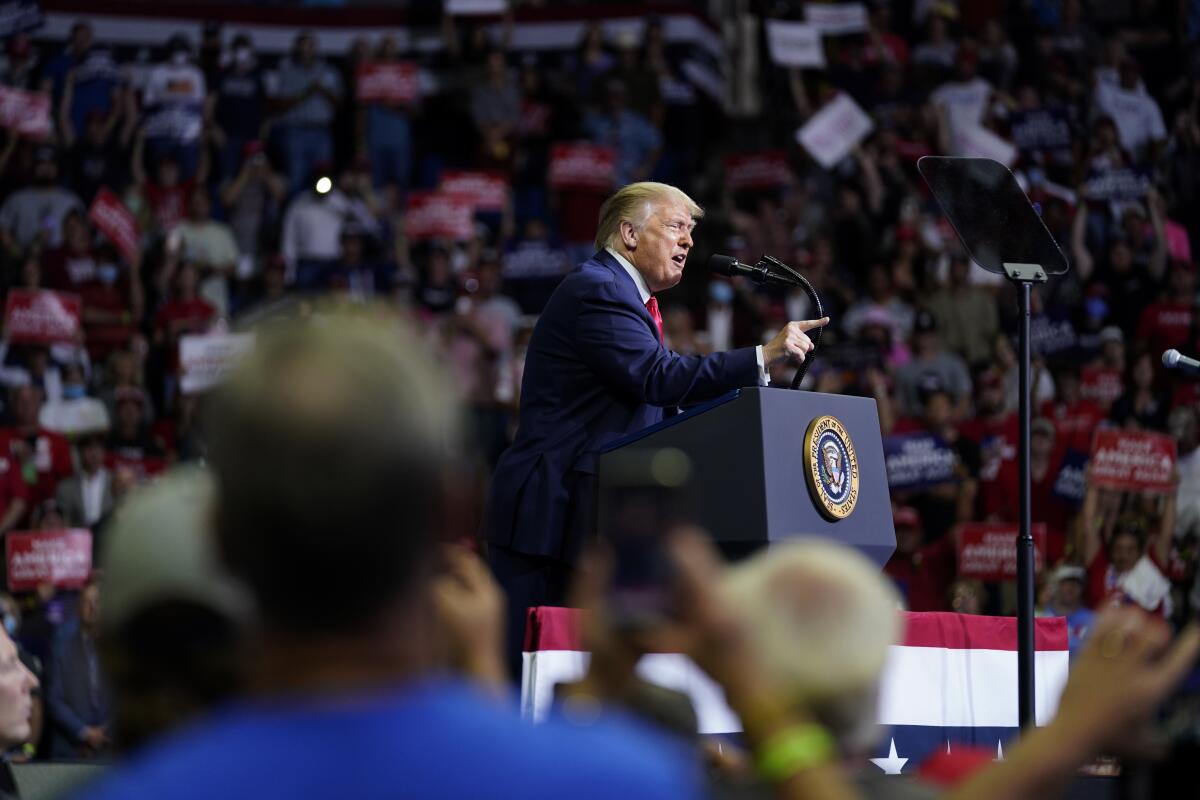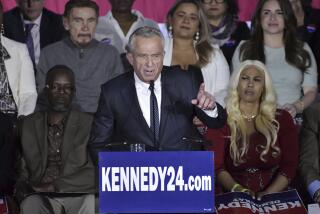Opinion: The link between anti-Black racism and Trump’s ‘kung flu’ comment

- Share via
In 1961, the American scholar Daniel J. Boorstin coined the term “pseudo-event” to describe an emerging tactic in the field of public relations: Saying or doing something with the sole purpose of generating media attention and publicity.
Nearly 60 years later, pseudo-events seem to comprise the majority of President Trump’s public utterances. He specializes in manufacturing outrage, and some would say we in the mainstream press have been slow to adapt ourselves to his nonstop outrage cycle, tailor-made for the era of 24/7 cable news and, now, social media.
And yet Trump’s latest ethnic slur — calling the deadly coronavirus “kung flu,” as he did at an anemically attended political rally in Tulsa, Okla., Saturday — deserves our condemnation, not least because of the pathetic and disingenuous defense his press secretary, Kayleigh McEnany, offered on Monday. Asked by the CBS News journalist Weijia Jiang why Trump was using a racist nickname for the virus, she replied: “The president doesn’t. What the president does do is point to the fact that the origin of the virus is China.”
Later, when Jiang asked about the widespread outrage in the Asian American community, McEnany responded — with astounding condescension — that Asian Americans are “amazing people and the spreading of the virus is not their fault in any way, shape or form.” She added, “They’re working closely with us to get rid of it. We will prevail together.”
That defense is, if possible, even worse than the original offense. By not specifying what she means by “us,” McEnany contributed to longstanding and pernicious stereotypes of Asians as dangerous outsiders. Xenophobia and racial animus contributed to the 1882 Chinese Exclusion Act, the World War II-era incarceration of Japanese Americans and hate crimes like the 1982 murder of Vincent Chin.
McEnany and the White House are not wrong to point out this new strain of coronavirus was first identified in Wuhan, China, nor is the Trump administration wrong in pointing out the deficiencies in the Chinese government’s handling of the pandemic in its early phases. But calling the coronavirus the “China virus” or the “Wuhan virus” — terms that are not used by the scientific community, which has called the virus SARS-CoV-2 — will only backfire, as it inhibits the very international cooperation needed to combat the wave of zoonoses — diseases that jump from animals to humans — that will continue to pose profound challenges to global health.
But there’s also a larger point that’s worth noting as we respond to Trump’s latest pseudo-event. Anti-Black racism and anti-Asian racism have often gone hand in hand, serving similar functions of distracting Americans from the common values and interests that should unite them. And the “kung flu” comment is but a taste of the kind of verbal abuse that Black Americans routinely face in our society.
It was in the years after Reconstruction, when the hopes and aspirations of Black freedom were dashed across the South, that the 1882 Chinese Exclusion Act was adopted. It was at the height of the Jim Crow era, in the 1920s, that Congress passed laws choking off immigration from Southern and Eastern Europe, motivated in part by fear of Catholics and Jews. And it was in the 1960s, in the same years that domestic activism and Cold War pressures prompted an expansion in civil rights, that immigration restrictions were finally eased. We whose families came to the United States following the adoption of the 1965 Immigration and Nationality Act owe a moral debt to the generations of African Americans whose agitation for political equality helped expand the definition of who gets to be American.
Madeline Y. Hsu, a scholar at the University of Texas who studies the history of transnationalism and Chinese migration to the United States, was momentarily speechless when asked Monday for a reaction to Trump’s remarks.
“It reads like a cheap pun used as a low-level jibe from someone who is ignorant and poorly educated, rather than the assessment of an extremely powerful leader who has for months had the fullest array of information about the nature and dangers of COVID-19,” Hsu said in an interview. “It’s something that a 6-year-old might say, trying to bully a classmate. Unfortunately the crudeness of the statement echoes the extreme mismanagement of the coronavirus pandemic and the callous endangering of millions of American lives. Even those who survive the illness suffer terribly, some for the long-term. It is even more of a tragedy that this illness arose with such a heartless demagogue in power.”
Frank H. Wu, who was the first Asian American to serve as a faculty member of a historically Black law school (at Howard University), has thought deeply about the need for solidarity between Black Americans and Asian Americans, noting that both communities have suffered from violent attacks, housing segregation, and even lynchings, particularly in the late 19th and early 20th centuries. Chinese immigrants had to carry permits to prove they had entered the United States legally, just as Black people in an earlier era had had to prove that they had permission to be away from places where they were enslaved or employed.
“Asians, especially Chinese, have faced a history in America of being described as dirty, the source of contagion,” wrote Wu, now a professor at UC Hastings College of the Law. “In San Francisco before the 1906 earthquake, for example, the bubonic plague outbreak was attributed to Chinese immigrants. The characterization of Chinese as filthy, living in a squalid Chinatown, as if they had chosen hyper segregation, was used in turn to justify continuing exclusion and further discrimination.”
While Asian Americans have not in the aggregate experienced the level of racism and violence that Black Americans have, rising anti-Chinese sentiment has been associated with hate crimes, including a recent stabbing in Texas.
K. Ian Shin, an assistant professor of American culture and history at the University of Michigan, noted in an interview the ways in which white supremacy and xenophobia have operated in tandem.
“History shows us that the way we talk about scientific phenomena can lead to the dehumanization of minority groups,” Shin said. “Whether it’s the ‘Oriental scale’ that afflicted citrus trees at the turn of the 20th century or the ‘Japanese beetles’ that infested the East Coast in the 1920s and 1930s, racist terms justified and enabled the containment and even eradication of Asian communities in the U.S. They paved the way for anti-Asian immigration legislation and wartime internment of Japanese Americans that we recognize today to be unjust and un-American.”
Trump’s usage of “kung flu” is a pseudo-event, intended to shock and distract. But if it has any use, it is in reminding us of how far we need to go to achieve racial progress. In describing Asian Americans as “amazing people,” McEnany was echoing — inadvertently, I imagine — Trump’s bizarre 2017 observation that “Frederick Douglass is an example of somebody who’s done an amazing job and is getting recognized more and more.”
Douglass was indeed amazing, for his expansive and capacious view of American freedom. And it would be amazing indeed if all Americans followed the moral example he set in resisting racism and xenophobia.
More to Read
A cure for the common opinion
Get thought-provoking perspectives with our weekly newsletter.
You may occasionally receive promotional content from the Los Angeles Times.











